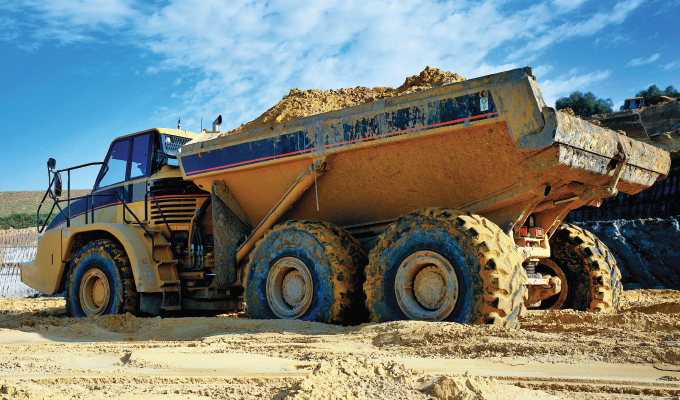By Eric Matson
Tires may seem like an afterthought in fleet management, but they are highly engineered products that serve as critical contributors to equipment productivity. Fleet operators put a substantial investment in tires, and they should protect that investment by maintaining them to the best of their ability. There are specific tools that Goodyear offers to make tire management easier and more valuable.
Fleets can first maintain their tires before they put them on equipment. Selecting the proper tire for your needs is the most basic way to ensure your tires last as long as possible. When selecting tires, fleet operators should consider the following:
- Tread pattern: Tread design should be carefully weighed, especially when determining what underfoot conditions your equipment will be operating in. When you have soft underfoot conditions, you should select a tire with tread that offers flotation and higher traction, such as Goodyear’s TL-3A+. More rocky, severe underfoot conditions require tires with a deeper, closed pattern tread that resists cutting and impact damage, such as Goodyear’s RL-5K.
- Tread compounds: The compounds in a tire’s tread can vary depending on the type of equipment being used. For example, loaders typically require ultra-abrasive compounds, such as Goodyear’s type 6, Goodyear’s most cut resistant compound. On the other hand, a load and carry loader or articulated haul truck may require more heat resistance, which would require Goodyear’s type 4 tread compound.
Goodyear has a large portfolio of products for fleet operators to choose from, catering to a wide range of needs for many equipment types. Goodyear products range from shallow L-3 and E-3 tires that are ideal for traction and flotation to our deep and aggressive L-4 and L-5 tires that suit severe underfoot conditions, which cause the risk of cutting.
In addition to selecting the proper tire, fleets should maintain the air pressure in their tires on a consistent basis. A simple way to remember to do this is to begin each day with a quick measure of inflation pressures. Proper tire inflation is one of the most effective maintenance methods fleet operators can practice to achieve optimal tire performance and reduce fuel expense.
It is also important for fleet operators to monitor their tires and construction sites for potential hazards that may impact the longevity of their tires. Goodyear’s field engineers work with customers to ensure their tires are operating efficiently. Some of the tire-related services Goodyear offers include:
- Fleet surveys: Tires are checked for inflation and tread depth, as well as cuts and nicks that may have the potential to grow into more troublesome issues over time. Monthly fleet surveys conducted by Goodyear or your tire service provider can help fleet operators identify and correct these minor issues before they become larger problems. This information should be recorded in some type of tire management program, such as Goodyear’s newly enhanced EMTrack.
- Site analysis: Goodyear tire experts carefully inspect customers’ jobsites for various conditions that cause early tire removals. By inspecting loading areas, hazards, such as rocks and other debris that have the potential to damage tires, are identified and corrected. They also inquire about water management, including drainage, standing water, and the potential for unexpected waters from roadways.
GOODYEAR TPMS HEAVY DUTY
In addition to hands-on tire services, Goodyear also offers tire management solutions for fleet operators to monitor the health of their tires. In 2018, Goodyear launched its Tire Pressure Monitoring System (TPMS) Heavy Duty in Europe, and recently announced the expansion of that service to North America.
Goodyear TPMS Heavy Duty is a data-based solution that enables precise, real-time monitoring of tires, which helps fleet operators optimize tire performance, reduce downtime, and improve total cost of ownership. To do this, a tire-fitted sensor collects and monitors tire pressure and temperature data in real time to detect under-inflated tires, air leaks, and mechanical issues. That information is recorded, analyzed, and delivered to fleets via text message, email, or reports from Goodyear’s web-based portal.
There are a variety of methods for fleet operators to maintain their tires, and each method can be used to manage different aspects of the tires.
CLOSING THOUGHT
Overall, by understanding the importance of tire management and working with a qualified Goodyear tire dealer to develop and enhance your own tire management program, you can help your tires perform to their potential, which can protect your investment and save you money in the future.
About the author:
OTR tire veteran Eric Matson is the global field engineering manager for The Goodyear Tire & Rubber Company’s OTR tire business. For more, visit www.goodyearotr.com.
Modern Contractor Solutions, March 2020
Did you enjoy this article?
Subscribe to the FREE Digital Edition of Modern Contractor Solutions magazine.



